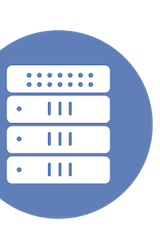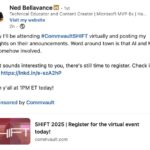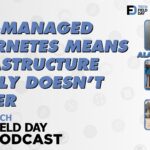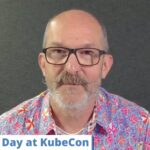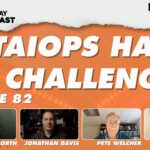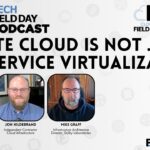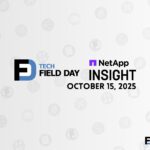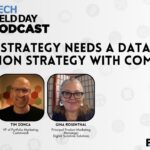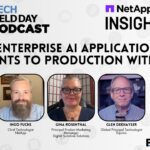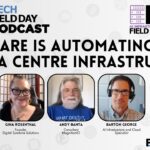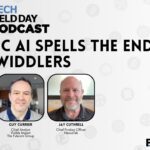Simplification in IT is an illusion; increasing complexity outpaces every effort to simplify. This episode of the Tech Field Day podcast, recorded on-site at Cloud Field Day 24, features Camberley Bates, Nathan Nielsen, Guy Currier, and Alastair Cooke. Cloud services and centralized management platforms offer simplified interfaces but also introduce a multitude of choices and underlying complexities. History matters; advancements from mainframes to PCs demonstrate continuously shifting goalposts, while the more recent integration of cloud and AI contributes to increased complexity. It may be that AI brings simply advanced simplicity, yet it may also bring the unintended consequence of people becoming “ignorant” of how IT works. CIOs and CTOs need to think strategically to manage increasingly complex environments, striking a balance between patchwork fixes and long-term strategic approaches.
Commvault Shift 2025 Live Blog
Join us for our coverage of Commvault Shift with our Live Blog! Tune in now to see what our delegates are saying.
DNS Must Be Secured Presented by Infoblox
DNS security is no longer optional. This service is not only being attacked by nefarious actors but it is also being leveraged in ways to compromise users and exfiltrate data. In this episode of the Tech Field Day podcast, brought to you by Infoblox, Tom Hollingsworth is joined by Jack Poller and Cricket Liu. They talk about the historical openness of DNS and how that has led to it becoming easy to see what users are doing and create ways to manipulate them. They discuss ways to secure the protocol and how companies like Infoblox are extending the capabilities for future security.
Well Managed Kubernetes Means Infrastructure Finally Doesn’t Matter
In a world of well-managed Kubernetes, we hoped that infrastructure finally wouldn’t matter. This episode of the Tech Field Day podcast features John Willis and Guy Currier wishing that infrastructure didn’t matter, with Alastair Cooke. Every new infrastructure revolution claims to make infrastructure invisible, from virtualization through HCI and cloud to containers and Kubernetes. The reality has always been that these revolutions shift the definition of infrastructure and bring some new aspect to be managed. Developers building features and applications want to focus on satisfying some business need, not considering storage devices and network configurations. Virtualization and Kubernetes both made delivering infrastructure easier, but neither eliminated infrastructure architecture and management. The dream of self-deploying and self-organizing infrastructure is as distant as it ever was. Agentic AI is the latest new hope to eliminate infrastructure challenges, yet it brings its own complex infrastructure requirements. Will we ever stop caring about IT infrastructure?
NetAIOps Has Its Challenges
The industry has embraced AI for every possible problem. Operations will eventually embrace it as well but questions remain about how it will be implemented. In this episode, Tom Hollingsworth sits down with Pete Welcher, Rita Younger, and Jonathan Davis to discuss the issues that remain with implementing AI into an operations workflow. They discuss licensing and procurement, the need for institutional knowledge, and how this will all work in a multivendor world. They wrap up with some guidance about how to approach your next big AIOps project.
Ready or Not, AI is Coming to the Enterprise
Despite widespread skepticism, AI is already widely used in the enterprise, often in the form of so-called shadow applications outside traditional IT. This episode of the Tech Field Day Podcast, recorded on the eve of AI Field Day, features delegates Ryan Booth and Dave Graham discussing the real state of AI adoption in the enterprise with host Stephen Foskett. Just like the advent of the PC, generative AI is widely used across businesses, typically on a bring-your-own basis rather than as a coordinated effort by the IT department. The same process happened in the Software-as-a-Service world, where each department and even individual adopted multiple tools that met their needs. There will soon be a reckoning, where businesses try to get their hands around all of the AI applications being used across the enterprise. The next step is to develop a plan to control sprawl of tools, models, data, and subscriptions to ensure that this shadow AI doesn’t become a risk to the company. Then companies need to be prepared as AI agents become critical to their operations, likely also deployed by individuals without corporate control.
Exploring the Future of Enterprise AI Deployment and Innovation at AI Field Day 7
Join Tech Field Day, Techstrong, Futurum, and our panel of independent experts for AI Field Day 7, live October 29th and 30th, 2025. Watch live on Techstrong TV, LinkedIn, and the Tech Field Day website, where you can also view the full schedule.
Private Cloud is Not just Self-Service Virtualization
Private cloud is not just virtualization 4.0, self-service VM deployment doesn’t fulfil the same need as the Public Cloud. This episode of the Tech Field Day podcast features Mike Graff, Jon Hildebrand, and Alastair Cooke. Private cloud has evolved from simple virtualization to a more comprehensive, cloud-like experience, emphasizing the need for on-premises infrastructure to offer the same developer-friendly tools and APIs as public clouds. Some application repatriation is driven by cost concerns and enabled by rise of technologies like Kubernetes and OpenShift for managing containerized workloads. A unified control plane for hybrid cloud environments is vital, as is accurate cost accounting for on-premises resources. Enterprises will search for a hybrid approach where developers can deploy applications without needing to worry about the underlying infrastructure.
The Evolution of Cloud at Cloud Field Day 24
Cloud Field Day 24 is back in San Francisco on October 22nd and 23rd, bringing the brightest minds in enterprise cloud together for two days of innovation, insight, and live demos.
Tech Field Day Experience at NetApp Insight 2025 Keynote Live Blog
Learn more about NetApp Insight 2025 during the Keynote in our delegate live blog!
Every AI Strategy Needs a Data Protection Strategy with Commvault
Every company lives in fear of a ransomware attack, whether they have suffered one or not, and this is even more critical in the era of AI. This episode of the Tech Field Day Podcast looks forward to Commvault SHIFT in November with a discussion of the importance of data protection to AI applications with Tim Zonca from Commvault, frequent delegate Gina Rosenthal, and host Stephen Foskett. AI applications are reliant on good data, and yet this same technology makes it easier for attackers to breach corporate controls. Today’s social engineering and phishing is more convincing than ever thanks to generative AI, and this has helped ransomware crews to adopt larger and more powerful attacks. Ransomware is a massive business, and it isn’t going away any time soon. At the same time, GenAI applications offer a new attack surface, as agentic AI is empowered to take action based on untrusted inputs. Not only can we not stop ransomware, but the pace and technical capabilities of these attacks keeps accelerating. There is reason for optimism, however, as data protection tools keep getting better. Today’s AI-optimized tools can effectively categorize data, burst or migrate to different locations, and roll back or recover from corruption or compromise. In the future, we will see increasing use of AI to monitor systems and data, detecting patterns and hardening the attack surface.
Moving Enterprise AI Applications From Experiments to Production with NetApp
Running enterprise applications in production is a lot different from the AI experiments many of us have been involved with so far. This episode of the Tech Field Day podcast, recorded prior to NetApp Insight 2025, features Ingo Fuchs from NetApp along with Gina Rosenthal, Glenn Dekhayser, and Stephen Foskett. AI applications often start as experiments with a limited data set, but once these are moved to production there are many critical decisions to be made. Data must be classified and cleaned, removing personal and financial data and proprietary information before it even reaches an LLM. Data also must be structured for embedding and vectorization prior to use by an LLM. And we have to ensure that data is up to date or the application will not serve the customer properly. Finally we have to consider whether it is proper and ethical to share and act on this data. Many of the challenges facing modern AI applications are similar to the historic issues faced by enterprise storage, and this is an area in which NetApp and their customers have decades of experience.
Passkeys are the Future
Passwords create friction and therefore users find ways around them. New technology such as secure enclaves and PKI allow us to create better solutions like passkeys. In this episode of the Tech Field Day Podcast. Alan Shimel and Kate Scarcella join Tom Hollingsworth to discuss the problems with traditional passwords and how passkeys overcome them. They also talk about why it has taken so long to adopt passkeys and what barriers remain to full implementation. The wrap up with a look at what might lay ahead on the horizon for the future of user security.
The Latest in Cybersecurity Innovation at Security Field Day 14
The world should be more secure, and Tech Field Day is helping make it that way with the latest edition of Security Field Day. The event features two full days of presentations from leading security companies, innovative startups, and expert delegates, all focused on keeping people and software safe in an ever-evolving threat landscape. Tune […]
Unified Flash Memory and Reduced HBM are Reshaping AI Training and Inference with Phison
AI will need less HBM (high bandwidth memory) because flash memory unification is changing training and inference. This episode of the Tech Field Day podcast features Sebastien Jean from Phison, Max Mortillaro, Brian Martin, and Alastair Cooke. Training, fine-tuning, and inference with Large Language Models traditionally use GPUs with high bandwidth memory to hold entire data models and data sets. Phison’s aiDaptiv+ framework offers the ability to trade lower cost of infrastructure against training speed or allow larger data sets (context) for inference. This approach enables users to balance cost, compute, and memory needs, making larger models accessible without requiring top-of-the-line GPUs, and giving smaller companies more access to generative AI.
Agentic AI Spells the End of Dial Twiddlers
If you haven’t already, start working with Generative AI now and make sure to control your ongoing costs. This episode of the Tech Field Day podcast features Russ Fellows, Mitch Lewis, and Brian Martin, all from Signal65, and is hosted by Alastair Cooke. Generative AI is delivering value to businesses of all sizes, but significant evolution in models and technologies remains before maturity is achieved. Experimentation is essential to understand the value of new technologies, starting with cloud resources or small-scale on-premises servers. Business value is derived from the inference stage, where AI tools generate actionable information for users. Generative AI is like a knowledgeable and well-intentioned intern; someone more senior must ensure AI is given good instructions and check their work. In production, grounding and guard rails are vital to keep your AI an asset, not a liability.







